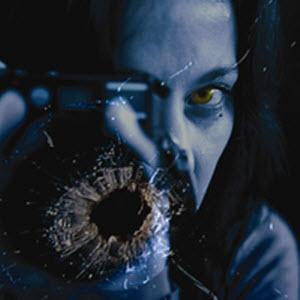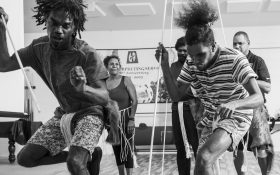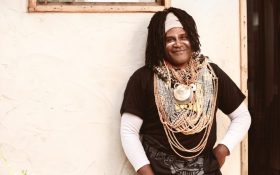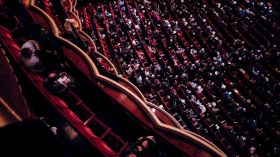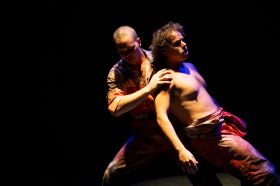As in a flipbook, fragments of a life are animated, moving through the war-zones of Bosnia, East Timor and Iraq. The limits of the space, of this photojournalist’s life, are constructed and dismantled, along with the ethics and moral boundaries of the situations that she is thrust into. Flashes of light explode from cameras, bombs and light-boxes. A chorus of actors bends in and out of liminal spaces, dodging and re-assembling the shrapnel, like snap-shots, telling a multiplicity of stories and possible versions/takes. The live music score (by award winning Jethro Woodward) is relentless, but beautifully so, writing in a phraseology that departs from the single elements of the narrative and deepens the echoes of metaphor.
This piece comes from writer Mari Lourey, who comes to this piece via a music career, various arts projects, critically acclaimed Dirty Angels (La Mama 2003), and award winning The Bridge (Green Room and Vic Health Award, 2003).
Nadja Kostich and an ensemble of experienced and talented actors, designers and musicians have developed this piece into an impressive work. Kostich has had extensive experience as a director in Melbourne, from working with Youth Platform Theatre (with Patricia Cornelius and Christos Tsolkas) to nominations and awards for projects produced by her own company paradigm productions. Her previous shows have all included multimedia elements and are highly physical. The same aesthetic is present here, in Bare Witness.
The aesthetic and use of back projections, music, light, movement, are indelibly integrated into the philosophy and aesthetic of the concepts of the play. Relationships between the elements are forged and dismembered, sometimes amplifying, sometimes contradicting, sometimes aping or echoing each other. It makes for a splintering of meaning and possibility. This is such a rare coalescence at a time when multimedia is a consistent crutch and distraction in much of live performance.
The aesthetic is not a linear or natural progression from the page, it is an extension of it, it complicates it. For example, given that we are dealing with photography and still images in the text, it would be a natural extension to project still images. But the only still images here are the ones the performers compose of one another, framing and reframing their world, their perspective. What is projected are animated images, and all of them manipulated in some way, deconstructed and put back together again into various versions of what may be. A wolf keeps haunting this backdrop, a lone wolf whose call signals danger while sounding remarkably like a woman’s keen, but the sound is only of the imagination because the wolf’s voice is never rendered present in our space. A deft hand has known what details to leave out of this sensorially very full production. There were moments of needless sentimentality and some echoes chimed too loudly, but these were thankfully swallowed up by the fast pace and we quickly moved over them.
The writer and director in the production notes speak about a desire to achieve a complex and undecided perspective. I think the text and the narrative elements of the piece offer binary and perhaps stale oppositions, as in: do I watch and photograph or do I help? Similarly, the moment of celebrating an amazing and ‘successful’ photograph is pitched against the subject of the photograph and the horror it depicts. This kind of set up of oppositions has the effect of a moralistic tale.
However, while the ideas in the text bounce around four fairly stable walls, the performers don’t work within this delimited space, they move across it in various shapes and roles and functions to dismantle and constantly change the boundaries, underscoring the text with more complex ideas. The bodies don’t occupy this then that position or space, we are allowed to watch them metamorphose into various shapes, watching the process of change and occupation of the liminal spaces. It is congruous that the peripheries of the room are in constant motion, and it would have been lovely if the ‘main focus’ or ‘action’ was also de-centered, the axis also contested. For this same reason I wished the count-down which is set up in the beginning, would never reach its expected end from 011 to 001, but it did come to this natural and expected conclusion.
There is a niggling sense that the text and narrative trajectory kept the production within conservative limits. However, the deft use of theatricality and the energy of the performers (including the musician and stage-hand), pushing it into a more complex terrain, makes for an interesting and strong piece of theatre.
Bare Witness
by Mari Lourey, directed by Nadja Kostich
music by: Jethro Woodward
design by: Marg Horwell
with: Isaac Drandic, Daniela Farinacci, Todd MacDonald, Adam McConvell and Maria Theodorakis
dates: Fri 10 Sep to Sat 26 Sep 10
hours: Tue – Sat 7:30pm; Sun 6.00pm
duration: 80 minutes approx
admission: Full $35; Concession $25; Groups $30; Preview (9 Sept) $15 / $10
discount tickets : Tuesday 14: $30 Full, $23 conc
bookings: 03 9662 9966 or book online
